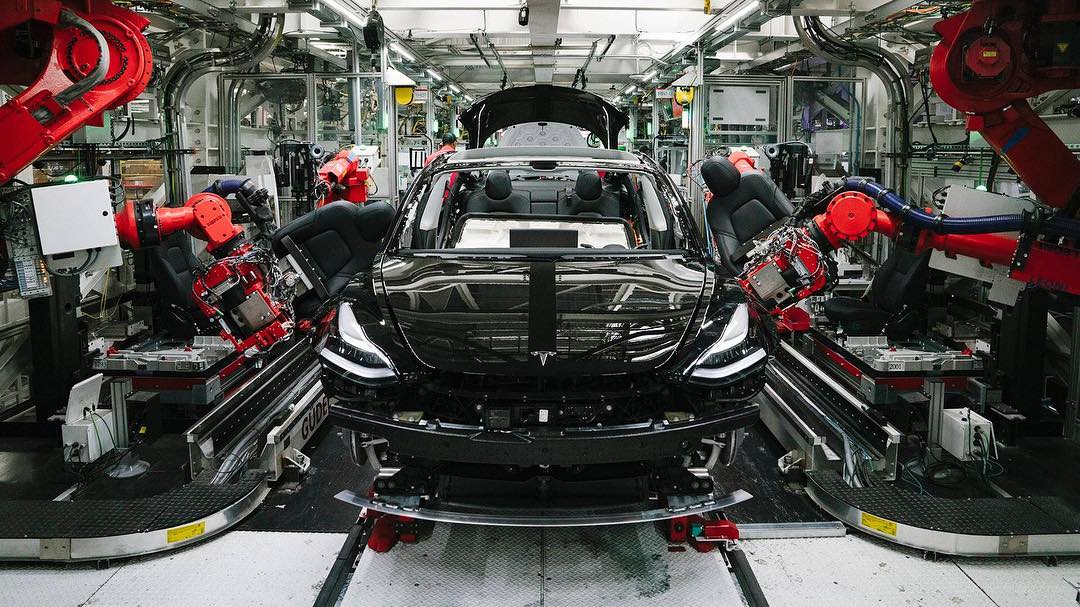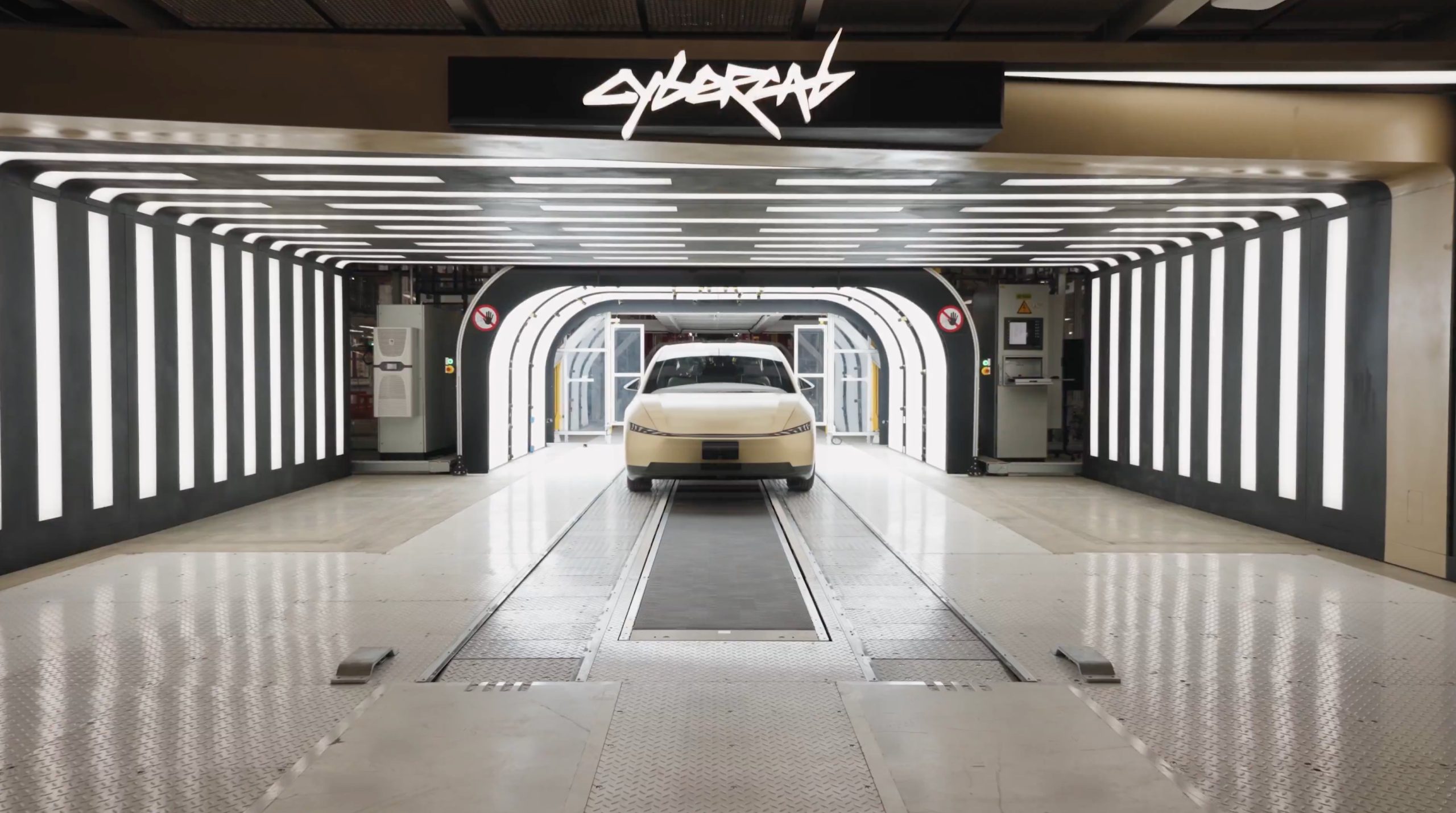

Investor's Corner
Tesla Model 3 drive unit production reportedly hits 10k/week amid end-of-Q3 push
Despite facing a lawsuit from the Securities and Exchange Commission about his “funding secured” tweet last August, Elon Musk appeared to be in light spirits on Friday, expressing his gratitude to the Tesla community for their help, at one point even posting a “Don’t Panic” reminder on his Twitter page. Musk reportedly rallied Tesla’s workers as well, stating that the company has achieved a notable milestone in its ongoing Model 3 ramp — the production of over 10,000 drive units in one week.
In a series of letters to employees following the release of the SEC’s lawsuit, Elon Musk reportedly urged Tesla’s workers to pay no attention to distractions. One of the letters, a copy of which was reportedly obtained by Bloomberg, stated that Tesla’s Model 3 drive team had produced “more than 10,000” units in a seven-day period. Musk reportedly praised the Tesla team as well, urging them to push through “one more hardcore weekend” as Q3 nears its close.
“You’re doing an incredible job. Ignore all distractions. One more hardcore weekend and we will be victorious,” Musk wrote.
And remember … pic.twitter.com/UaDUv4OlZf
— Elon Musk (@elonmusk) September 28, 2018
The Model 3’s drive units are manufactured in Gigafactory 1, Tesla’s expansive facility in Nevada, which is also tasked with the production of the electric sedan’s batteries. The update on Gigafactory 1’s 10,000/week Model 3 drive unit production comes amidst news that Tesla’s battery partner Panasonic is aiming to complete three new battery cell assembly lines in the facility earlier than expected. This was related by Yoshio Ito, head of Panasonic’s automotive business, who also noted that the bottlenecks in Gigafactory were primarily due to the Japanese company’s incapability to produce enough batteries to meet Tesla’s demand.
Panasonic’s new battery assembly lines are not the only upgrades set to be installed in Gigafactory 1. After a tour of the facility, analysts from Worm Capital stated that Tesla is also expecting the arrival of new machines from Grohmann Automation, all of which are designed to boost the facility’s production capabilities. During the Gigafactory 1 tour, Tesla head of investor relations Martin Viecha reportedly noted that the new Grohmann machines would help battery module production become “three times faster, and three times cheaper.” The new Grohmann machines are expected to be sent to Gigafactory 1 by the end of Q3 or the beginning of Q4.
Tesla might be on track to produce and deliver a record number of Model 3 to reservation holders this quarter, but the ramp of the vehicle remains only partly complete. Ultimately, Tesla aims to produce as many as 10,000 units of the electric sedan per week, including the highly-anticipated $35,000 Standard Range RWD Model 3, which is expected to start production sometime in 2019. If the emails obtained by Bloomberg are accurate, then it would mean that Tesla’s Model 3 drive unit production has taken a definitive step forward.
Considering Tesla’s 10,000/week milestone with its Model 3 drive unit production, as well as the upcoming upgrades to Gigafactory 1 in the form of Panasonic’s new battery cell assembly lines and Grohmann’s new machines, Q4 2018 is shaping up to be a historic quarter for the electric car maker.

Investor's Corner
Tesla Full Self-Driving statistic impresses Wall Street firm: ‘Very close to unsupervised’
The data shows there was a significant jump in miles traveled between interventions as Tesla transitioned drivers to v14.1 back in October. The FSD Community Tracker saw a jump from 441 miles to over 9,200 miles, the most significant improvement in four years.

Tesla Full Self-Driving performance and statistics continue to impress everyone, from retail investors to Wall Street firms. However, one analyst believes Tesla’s driving suite is “very close” to achieving unsupervised self-driving.
On Tuesday, Piper Sandler analyst Alexander Potter said that Tesla’s recent launch of Full Self-Driving version 14 increased the number of miles traveled between interventions by a drastic margin, based on data compiled by a Full Self-Driving Community Tracker.
🚨 Piper Sandler reiterated its Overweight rating and $500 PT on Tesla $TSLA stock
Analyst Alexander Potter said FSD is near full autonomy and latest versions showed the largest improvement in disengagements, from 440 miles to 9,200 miles between critical interventions pic.twitter.com/u4WCLfZcA9
— TESLARATI (@Teslarati) December 9, 2025
The data shows there was a significant jump in miles traveled between interventions as Tesla transitioned drivers to v14.1 back in October. The FSD Community Tracker saw a jump from 441 miles to over 9,200 miles, the most significant improvement in four years.
Interestingly, there was a slight dip in the miles traveled between interventions with the release of v14.2. Piper Sandler said investor interest in FSD has increased.
Full Self-Driving has displayed several improvements with v14, including the introduction of Arrival Options that allow specific parking situations to be chosen by the driver prior to arriving at the destination. Owners can choose from Street Parking, Parking Garages, Parking Lots, Chargers, and Driveways.
Additionally, the overall improvements in performance from v13 have been evident through smoother operation, fewer mistakes during routine operation, and a more refined decision-making process.
Early versions of v14 exhibited stuttering and brake stabbing, but Tesla did a great job of confronting the issue and eliminating it altogether with the release of v14.2.
Tesla CEO Elon Musk also recently stated that the current v14.2 FSD suite is also less restrictive with drivers looking at their phones, which has caused some controversy within the community.
Although we tested it and found there were fewer nudges by the driver monitoring system to push eyes back to the road, we still would not recommend it due to laws and regulations.
Tesla Full Self-Driving v14.2.1 texting and driving: we tested it
With that being said, FSD is improving significantly with each larger rollout, and Musk believes the final piece of the puzzle will be unveiled with FSD v14.3, which could come later this year or early in 2026.
Piper Sandler reaffirmed its $500 price target on Tesla shares, as well as its ‘Overweight’ rating.
Investor's Corner
Tesla gets price target boost, but it’s not all sunshine and rainbows

Tesla received a price target boost from Morgan Stanley, according to a new note on Monday morning, but there is some considerable caution also being communicated over the next year or so.
Morgan Stanley analyst Andrew Percoco took over Tesla coverage for the firm from longtime bull Adam Jonas, who appears to be focusing on embodied AI stocks and no longer automotive.
Percoco took over and immediately adjusted the price target for Tesla from $410 to $425, and changed its rating on shares from ‘Overweight’ to ‘Equal Weight.’
Percoco said he believes Tesla is the leading company in terms of electric vehicles, manufacturing, renewable energy, and real-world AI, so it deserves a premium valuation. However, he admits the high expectations for the company could provide for a “choppy trading environment” for the next year.
He wrote:
“However, high expectations on the latter have brought the stock closer to fair valuation. While it is well understood that Tesla is more than an auto manufacturer, we expect a choppy trading environment for the TSLA shares over the next 12 months, as we see downside to estimates, while the catalysts for its non-auto businesses appear priced at current levels.”
Percoco also added that if market cap hurdles are achieved, Morgan Stanley would reduce its price target by 7 percent.
Perhaps the biggest change with Percoco taking over the analysis for Jonas is how he will determine the value of each individual project. For example, he believes Optimus is worth about $60 per share of equity value.
He went on to describe the potential value of Full Self-Driving, highlighting its importance to the Tesla valuation:
“Full Self Driving (FSD) is the crown jewel of Tesla’s auto business; we believe that its leading-edge personal autonomous driving offering is a real game changer, and will remain a significant competitive advantage over its EV and non-EV peers. As Tesla continues to improve its platform with increased levels of autonomy (i.e., hands-off, eyes-off), it will revolutionize the personal driving experience. It remains to be seen if others will be able to keep pace.”
Additionally, Percoco outlined both bear and bull cases for the stock. He believes $860 per share, “which could be in play in the next 12 months if Tesla manages through the EV-downturn,” while also scaling Robotaxi, executing on unsupervised FSD, and scaling Optimus, is in play for the bull case.
Will Tesla thrive without the EV tax credit? Five reasons why they might
Meanwhile, the bear case is placed at $145 per share, and “assumes greater competition and margin pressure across all business lines, embedding zero value for humanoids, slowing the growth curve for Tesla’s robotaxi fleet to reflect regulatory challenges in scaling a vision-only perception stack, and lowering market share and margin profile for the autos and energy businesses.”
Currently, Tesla shares are trading at around $441.
Investor's Corner
Tesla bear gets blunt with beliefs over company valuation

Tesla bear Michael Burry got blunt with his beliefs over the company’s valuation, which he called “ridiculously overvalued” in a newsletter to subscribers this past weekend.
“Tesla’s market capitalization is ridiculously overvalued today and has been for a good long time,” Burry, who was the inspiration for the movie The Big Short, and was portrayed by Christian Bale.
Burry went on to say, “As an aside, the Elon cult was all-in on electric cars until competition showed up, then all-in on autonomous driving until competition showed up, and now is all-in on robots — until competition shows up.”
Tesla bear Michael Burry ditches bet against $TSLA, says ‘media inflated’ the situation
For a long time, Burry has been skeptical of Tesla, its stock, and its CEO, Elon Musk, even placing a $530 million bet against shares several years ago. Eventually, Burry’s short position extended to other supporters of the company, including ARK Invest.
Tesla has long drawn skepticism from investors and more traditional analysts, who believe its valuation is overblown. However, the company is not traded as a traditional stock, something that other Wall Street firms have recognized.
While many believe the company has some serious pull as an automaker, an identity that helped it reach the valuation it has, Tesla has more than transformed into a robotics, AI, and self-driving play, pulling itself into the realm of some of the most recognizable stocks in tech.
Burry’s Scion Asset Management has put its money where its mouth is against Tesla stock on several occasions, but the firm has not yielded positive results, as shares have increased in value since 2020 by over 115 percent. The firm closed in May.
In 2020, it launched its short position, but by October 2021, it had ditched that position.
Tesla has had a tumultuous year on Wall Street, dipping significantly to around the $220 mark at one point. However, it rebounded significantly in September, climbing back up to the $400 region, as it currently trades at around $430.
It closed at $430.14 on Monday.








